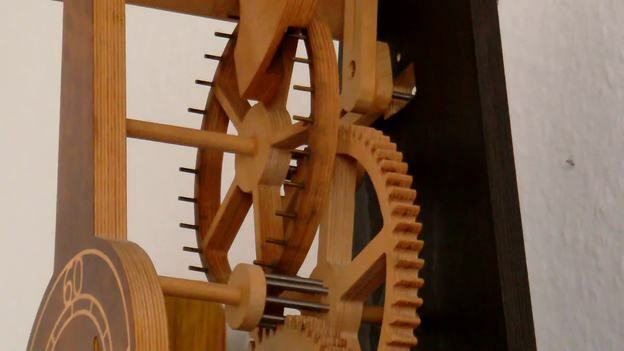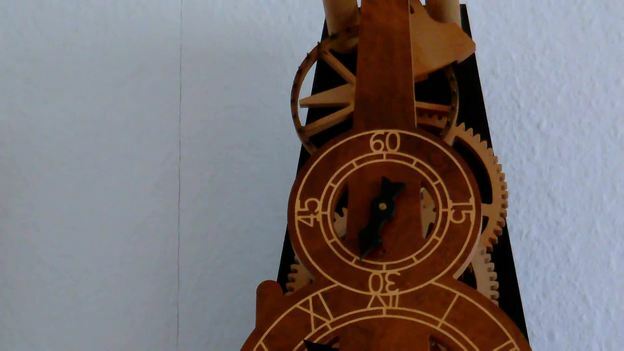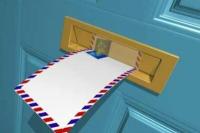VIDEO: Set the pendulum clock correctly
To get straight to the point: old pendulum clocks that are wound with weights will seldom achieve the accuracy of a modern quartz or even radio-controlled clock. You should tolerate a failure of one to two minutes a day.
The pendulum clock has an adjusting screw
In a pendulum clock, the pendulum is the clock for the gears. A wall clock is usually a seconds pendulum. A large grandfather clock has a longer pendulum. The period of oscillation, i.e. the back and forth, of the pendulum should be exactly one second. It depends on the length of the pendulum: If the pendulum becomes longer, the period of oscillation increases and vice versa. This is how you can adjust the pendulum length yourself:
-
Find the adjusting screw. At the bottom of the pendulum, find the small adjusting screw or nut that you can use to set the active pendulum length by turning it.

The adjusting screw is located on the pendulum. © Dr. Hannelore Dittmar-Ilgen -
Turn the screw. Turn the screw a little to the left or right.

Turn the screw to adjust the pendulum length. © Dr. Hannelore Dittmar-Ilgen - Turn carefully. But be careful: everything was changed all too quickly. It is often sufficient to change the adjusting screw by a quarter or half a turn.
-
Check accuracy. Now wait a few hours to check the accuracy of the watch. You can use precise quartz clocks or radio clocks to check the master clock.

Check the accuracy carefully. © Benjamin Roch -
Fix error. If the gait error has increased, you have to choose the other direction. If the gait error has become smaller, you should keep the originally selected direction of rotation of the screw a little longer in order to further minimize the gait error.

Adjust the pendulum again if there are major errors in the rate. © Benjamin Roch
A real pendulum clock is a very complex mechanical structure. These …
Some pendulum clocks have small weights at the bottom of the pendulum that can be pushed up or down. The active pendulum length also changes. If you push this weight up slightly, the period of oscillation will be shorter. The clock is now running faster. This will fix the clock slowing down.
Adjust the pendulum length with a metronome
You will have noticed it: Setting the accuracy requires patience and time. Because you have to wait again and again to see how the clock reacts before you change the pendulum length again. With a metronome or a stop watch as a clock, you can set the pendulum length more quickly:
- Use clock. With the metronome you set an acoustic beat of one second. This corresponds to a frequency of one Hertz. You just start the stop watch.
- Let go of the pendulum. Now let go of the pendulum on your wall clock to match the beat.
- Compare gear. Compare the rate of the metronome or stop watch and your pendulum clock. You will be amazed how quickly small deviations become noticeable.
- Adjust pendulum length. Set the pendulum length as described.
This is how a pendulum clock works
If you want to measure times correctly, you need the right equipment. Sundials are probably the oldest timepieces. They use the shadow of a thin stick. In ancient times, water clocks were developed that worked with good precision. The leakage of water from a vessel with a fine opening was measured. The physicist Galileo Galilei used clocks like this to determine the time in his famous drop tests. Today's egg timers filled with sand are still reminiscent of this method.
However, Galileo is said to have already thought about measuring time with the help of pendulums. According to an anecdote, the idea of such a clock should be given to him during an endless sermon have come: A lamp hangs down from a church ceiling and swings at equal time intervals.
He discovered that the period of oscillation only depends on the length of the pendulum and made a sketch for the clock. However, it was not until 1657 that the Dutch Christian Huygens built the first clock regulated by a pendulum. It even had a minute hand and was accurate to about five minutes a day.
Since every pendulum gradually comes to rest as a result of friction, it has to be constantly supplied with energy. This is usually done by lowering weights: with each oscillation, the pendulum is given a small push. the Lever escapement determines this point in time at which the energy is supplied and at the same time limits its duration.


